Fifth-Generation (5G) mmWave Spatial Channel Characterization for Urban Environments’ System Analysis
Abstract
1. Introduction
2. Background
3. Wireless Channel Characterization
3.1. Deterministic 3D Ray Launching Algorithm
3.2. Scenario Description
3.3. Large-Scale Propagation
3.4. Small-Scale Propagation
3.5. Statistical Analysis
3.6. Interference Analysis
4. Conclusions
Author Contributions
Funding
Acknowledgments
Conflicts of Interest
References
- IFNTRW Group. IEEE 5G and Beyond Technology Roadmap, White Paper. IEEE Tech. Rep. 2017, 1–33. [Google Scholar]
- Agiwal, M.; Roy, A.; Saxena, N. Next Generation 5G Wireless Networks: A Comprehensive Survey. IEEE Commun. Surv. Tutor. 2016, 18, 1617–1655. [Google Scholar] [CrossRef]
- Rappaport, T.S.; Xing, Y.; MacCartney, G.R.; Molisch, A.F.; Mellios, E.; Zhang, J. Overview of Millimeter Wave Communications for Fifth-Generation (5G) Wireless Networks-with a focus on Propagation Models. IEEE Trans. Antennas Propag. 2017, 65, 6213–6230. [Google Scholar] [CrossRef]
- Karaboytcheva, M. Effects of 5G wireless communication on human health. Eur. Parliam. Res. Serv. PE 2020, 646, 172. [Google Scholar]
- Di Ciaula, A. Towards 5G communication systems: Are there health implications? Int. J. Hyg. Environ. Health 2018, 211, 367–375. [Google Scholar] [CrossRef]
- Review of Published Literature between 2008 and 2018 of Relevance to Radiofrequency Radiation and Cancer, U.S. Food & Drug Administration. March 2020. Available online: https://www.fda.gov/media/135043/download (accessed on 17 September 2020).
- Simkó, M.; Mattsson, M.-O. 5G Wireless Communication and Health Effects—A Pragmatic Review Based on Available Studies Regarding 6 to 100 GHz. Int. J. Environ. Res. Public Health 2019, 16, 3406. [Google Scholar] [CrossRef]
- IARC/OMS. World Cancer Report 2020—Cancer Research for Cancer Prevention; IARC/OMS: Lyon, France, 2020. [Google Scholar]
- Xu, B.; Zhao, K.; Ying, Z.; Sjöberg, D.; He, W.; He, S. Analysis of Impacts of Expected RF EMF Exposure Restrictions on Peak EIRP of 5G User Equipment at 28 GHz and 39 GHz Bands. IEEE Access 2019, 7, 20996–21005. [Google Scholar] [CrossRef]
- Colombi, D.; Thors, B.; TöRnevik, C.; Balzano, Q. RF Energy Absorption by Biological Tissues in Close Proximity to Millimeter-Wave 5G Wireless Equipment. IEEE Access 2018, 6, 4974–4981. [Google Scholar] [CrossRef]
- World Health Organization (WHO). Fact Sheet 304, “Base Stations and Wireless Technology”. May 2006. Available online: http://www.who.int/peh-emf/publications/factsheets/en/ (accessed on 17 September 2020).
- Huang, J.; Liu, Y.; Wang, C.X.; Sun, J.; Xiao, H. 5G Millimeter wave channel sounders, measurements, and models: Recent developments and future challenges. IEEE Commun. Mag. 2019, 57, 138–145. [Google Scholar] [CrossRef]
- Hussain, S.; Brennan, C. Efficient Preprocessed Ray Tracing for 5G Mobile Transmitter Scenarios in Urban Microcellular Environments. IEEE Trans. Antennas Propag. 2019, 67, 3323–3333. [Google Scholar] [CrossRef]
- Peng, B.; Guan, K.; Küter, A.; Rey, S.; Pätzold, M.; Kürner, T. Channel Modeling and System Concepts for Future Terahertz Communications. IEEE Veh. Technol. Mag. 2020, 15, 136–143. [Google Scholar] [CrossRef]
- Chettri, L.; Bera, R. A Comprehensive Survey on Internet of Things (IoT) Toward 5G Wireless Systems. IEEE Internet Things J. 2020, 7, 16–32. [Google Scholar] [CrossRef]
- Shafi, M.; Zhang, J.; Tataria, H.; Molisch, A.F.; Sun, S.; Rappaport, T.S.; Tufvesson, F.; Wu, S.; Kitao, K. Microwave vs. Millimeter-Wave Propagation Channels: Key Differences and Impact on 5G Cellular Systems. IEEE Commun. Mag. 2018, 56, 14–20. [Google Scholar] [CrossRef]
- Azpilicueta, L.; Vargas-Rosales, C.; Falcone, F. Intelligent Vehicle Communication: Deterministic Propagation Prediction in Transportation Systems. IEEE Veh. Technol. Mag. 2016, 11, 29–37. [Google Scholar] [CrossRef]
- Samimi, M.K.; Rappaport, T.S. 3-D Millimeter-Wave Statistical Channel Model for 5G Wireless System Design. IEEE Trans. Microw. Theory Tech. 2016, 64, 2207–2225. [Google Scholar] [CrossRef]
- Tian, L.; Degli-Esposti, V.; Vitucci, E.M.; Yin, X. Semi-Deterministic Radio Channel Modeling Based on Graph Theory and Ray-Tracing. IEEE Trans. Antennas Propag. 2016, 64, 2475–2486. [Google Scholar] [CrossRef]
- Williams, K.; Tirado, L.; Chen, Z.; Gonzalez-Valdes, B.; Martinez, J.A. Ray tracing for simulation of millimeter-wave whole body imaging systems. IEEE Trans. Antennas Propag. 2015, 63, 5913–5918. [Google Scholar] [CrossRef]
- He, D.; Ai, B.; Guan, K.; Wang, L.; Zhong, Z.; Kürner, T. The design and applications of high-performance ray-tracing simulation platform for 5G and beyond wireless communications: A tutorial. IEEE Commun. Surv. Tutor. 2019, 21, 10–27. [Google Scholar] [CrossRef]
- He, D.; Ai, B.; Guan, K.; Zhong, Z.; Hui, B.; Kim, J.; Chung, H.; Kim, I. Channel measurement, simulation, and analysis for high-speed railway communications in 5g millimeter-wave band. IEEE Trans. Intell. Transp. Syst. 2018, 19, 3144–3158. [Google Scholar] [CrossRef]
- Karttunen, A.; Molisch, A.F.; Hur, S.; Park, J.; Zhang, C.J. Spatially Consistent Street-by-Street Path Loss Model for 28-GHz Channels in Micro Cell Urban Environments. IEEE Trans. Wirel. Commun. 2017, 16, 7538–7550. [Google Scholar] [CrossRef]
- Lee, J.H.; Choi, J.; Lee, J.Y.; Kim, S.C. 28 GHz Millimeter-Wave Channel Models in Urban Microcell Environment Using Three-Dimensional Ray Tracing. IEEE Antennas Wirel. Propag. Lett. 2018, 17, 426–429. [Google Scholar] [CrossRef]
- Hur, S.; Baek, S.; Kim, B.; Chang, Y.; Molisch, A.F.; Rappaport, T.S.; Haneda, K.; Park, J.; Institute of Electrical and Electronics Engineers Inc. Proposal on millimeter-wave channel modeling for 5G cellular system. IEEE J. Sel. Top. Signal. Process. 2016, 10, 454–469. [Google Scholar] [CrossRef]
- Thomas, T.A.; Rybakowski, M.; Sun, S.; Rappaport, T.S.; Nguyen, H.; Kovacs, I.Z.; Rodriguez, I. A Prediction Study of Path Loss Models from 2–73.5 GHz in an Urban-Macro Environment. In Proceedings of the 83rd IEEE Vehicular Technology Conference (VTC2016) spring, Nanjing, China, 9–13 May 2016. [Google Scholar]
- Rose, D.M.; Rey, S.; Kumer, T. Differential 3D ray-Launching using Arbitrary Polygonal Shapes in Time-Variant Indoor Scenarios. In Proceedings of the Global Symposium on Millimeter Waves (GSMM) & ESA Workshop on Millimeter-Wave Technology and Applications, Espoo, Finland, 6–8 June 2016. [Google Scholar]
- Fuschini, F.; Häfner, S.; Zoli, M.; Müller, R.; Vitucci, E.M.; Dupleich, D.; Barbiroli, M.; Luo, J.; Schulz, E.; Degli-Esposti, V.; et al. Analysis of In-Room mm-Wave Propagation: Directional Channel Measurements and Ray Tracing Simulations. J. Infraredmillim. Terahertz Waves 2017, 38, 727–744. [Google Scholar] [CrossRef]
- Fuschini, F.; Zoli, M.; Vitucci, E.M.; Barbiroli, M.; Degli-Esposti, V. A Study on Millimeter-Wave Multiuser Directional Beamforming Based on Measurements and Ray Tracing Simulations. IEEE Trans. Antennas Propag. 2019, 67, 2633–2644. [Google Scholar] [CrossRef]
- Ai, B.; Guan, K.; He, R.; Li, J.; Li, G.; He, D.; Zhong, Z.; Huq, K.M.S. On Indoor MillimeterWave Massive MIMO Channels: Measurement and Simulation. IEEE J. Sel. Areas Commun. 2017, 35, 1678–1690. [Google Scholar] [CrossRef]
- Zhou, A.; Huang, J.; Sun, J.; Zhu, Q.; Wang, C.X.; Yang, Y. 60 GHz channel measurements and ray tracing modeling in an indoor environment. In Proceedings of the 9th International Conference on Wireless Communications and Signal. Processing (WCSP 2017), Nanjing, China, 11–13 October 2017; pp. 1–6. [Google Scholar] [CrossRef]
- Liu, J.; Matolak, D.W.; Mohsen, M.; Chen, J. Path loss modeling and ray-tracing verification for 5/31/90 GHz indoor channels. In Proceedings of the IEEE Vehicular Technology Conference, Honolulu, HI, USA, 22–25 September 2019. [Google Scholar] [CrossRef]
- Hossain, F.; Geok, T.K.; Rahman, T.A.; Hindia, M.N.; Dimyati, K.; Tso, C.P.; Kamaruddin, M.N. A smart 3D RT method: Indoor radio wave propagation modelling at 28 GHz. Symmetry 2019, 11, 510. [Google Scholar] [CrossRef]
- Li, S.; Liu, Y.; Lin, L.; Sun, D.; Yang, S.; Sun, X. Simulation and Modeling of Millimeter-Wave Channel at 60 GHz in Indoor Environment for 5G Wireless Communication System. In Proceedings of the 2018 IEEE International Conference on Computational Electromagnetics, ICCEM 2018, Chengdu, China, 26–28 March 2018. [Google Scholar] [CrossRef]
- Avazov, N.; Riazul Islam, S.M.; Park, D.; Kwak, K.S. Statistical Characterization of a 3-D PropagationModel for V2V Channels in Rectangular Tunnels. IEEE Antennas Wirel. Propag. Lett. 2017, 18, 2392–2395. [Google Scholar] [CrossRef]
- Petrov, V.; Kokkoniemi, J.; Moltchanov, D.; Lehtomäki, J.; Juntti, M.; Koucheryavy, Y. The Impact of Interference from the Side Lanes on mmWave/THz Band V2V Communication Systems with Directional Antennas. IEEE Trans. Veh. Technol. 2018, 67, 5028–5041. [Google Scholar] [CrossRef]
- Wang, Y.; Venugopal, K.; Molisch, A.F.; Heath, R.W. MmWave Vehicle-to-Infrastructure Communication: Analysis of Urban Microcellular Networks. IEEE Trans. Veh. Technol. 2018, 67, 7086–7100. [Google Scholar] [CrossRef]
- Lee, J.; Kim, K.-W.; Kim, M.-D.; Park, J.-J. Measurement-Based Millimeter-Wave Angular and Delay Dispersion Characteristics of Outdoor-to-Indoor Propagation for 5G Millimeter-Wave Systems. IEEE Access 2019, 7, 150492–150504. [Google Scholar] [CrossRef]
- Sulyman, A.I.; Alwarafy, A.; MacCartney, G.R.; Rappaport, T.S.; Alsanie, A. Directional Radio Propagation Path Loss Models for Millimeter-Wave Wireless Networks in the 28-, 60-, and 73-GHz Bands. IEEE Trans. Wirel. Commun. 2016, 15, 6939–6947. [Google Scholar] [CrossRef]
- Luini, L.; Roveda, G.; Zaffaroni, M.; Costa, M.; Riva, C.G. The Impact of Rain on Short E-Band Radio Links for 5G Mobile Systems: Experimental Results and Prediction Models. IEEE Trans. Antennas Propag. 2020, 68, 3124–3134. [Google Scholar] [CrossRef]
- Chiaraviglio, L.; Cacciapuoti, A.S.; Di Martino, G.; Fiore, M.; Montesano, M.; Trucchi, D.; Melazzi, N.B. Planning 5G Networks Under EMF Constraints: State of the Art and Vision. IEEE Access 2018, 6, 51021–51037. [Google Scholar] [CrossRef]
- Zhou, P.; Fang, X.; Wang, X.; Long, Y.; He, R.; Han, X. Deep Learning-Based Beam Management and Interference Coordination in Dense mmWave Networks. IEEE Trans. Veh. Technol. 2019, 68, 592–603. [Google Scholar] [CrossRef]
- Wang, C.X.; Di Renzo, M.; Stanczak, S.; Wang, S.; Larsson, E.G. Artificial Intelligence Enabled Wireless Networking for 5G and Beyond: Recent Advances and Future Challenges. IEEE Wirel. Commun. 2020, 27, 16–23. [Google Scholar] [CrossRef]
- Azpilicueta, L.; Astrain, J.J.; Lopez-Iturri, P.; Granda, F.; Vargas-Rosales, C.; Villadangos, J.; Perallos, A.; Bahillo, A.; Falcone, F. Optimization and Design of Wireless Systems for the Implementation of Context Aware Scenarios in Railway Passenger Vehicles. IEEE Trans. Intell. Transp. Syst. 2017, 18, 2838–2850. [Google Scholar] [CrossRef]
- Rappaport, T.S.; Heath, R.W., Jr.; Daniels, R.C.; Murdock, J.N. Millimeter Wave Wireless Communications; Prentice Hall Communications Engineering and Emerging Technologies Series; Prentice Hall PTR: Upper Saddle River, NJ, USA, 2015. [Google Scholar]
- Azpilicueta, L.; Rawat, M.; Rawat, K.; Ghannouchi, F.; Falcone, F. A Ray Launching-Neural Network Approach for Radio Wave Propagation Analysis in Complex Indoor Environments. IEEE Trans. Antennas Propag. 2014, 62, 2777–2786. [Google Scholar] [CrossRef]
- Azpilicueta, L.; Falcone, F.; Janaswamy, R. A Hybrid Ray Launching-Diffusion Equation Approach for Propagation Prediction in Complex Indoor Environments. IEEE Antennas Wirel. Propag. Lett. 2017, 16, 214–217. [Google Scholar] [CrossRef]
- Casino, F.; Azpilicueta, L.; López-Iturri, P.; Aguirre, E.; Falcone, F.; Solanas, A. Optimised Wireless Channel Characterisation in Large Complex Environments by Hybrid Ray Launching-Collaborative Filtering Approach. IEEE Antennas Wirel. Propag. Lett. 2017, 16, 780–783. [Google Scholar] [CrossRef]
- Azpilicueta, L.; Rawat, M.; Rawat, K.; Ghannouchi, F.; Falcone, F. Convergence Analysis in Deterministic 3D Ray Launching Radio Channel Estimation in Complex Environments. ACES J. 2014, 29, 256–271. [Google Scholar]
- Liya, B.N.; Michelson, D.G. Characterization of Multipath Persistence in Device-to-Device Scenarios at 30 GHz. In Proceedings of the 2016 IEEE Globecom Workshops, Washington, DC, USA, 4–8 December 2016. [Google Scholar]
- Salous, S. COST IC1004 White Paper on Channel Measurements and Modeling for 5G Networks in the Frequency Bands above 6 GHz; Euro-Cost: Durham, UK, 2016. [Google Scholar]
- Giordani, M.; Mezzavilla, M.; Zorzi, M. Initial Access in 5G mmWave Cellular Networks. IEEE Commun. Mag. 2016, 11, 40–47. [Google Scholar] [CrossRef]
- Rappaport, T.S.; MacCartney, G.R.; Sun, S.; Yan, H.; Deng, S. Small-Scale, Local Area, and Transitional Millimeter Wave Propagation for 5G Communications. IEEE Trans. Antennas Propag. 2017, 65, 6474–6490. [Google Scholar] [CrossRef]
- Hashemi, M.; Koksal, C.E.; Shroff, N.B. Hybrid RF-mmWave Communication to Achieve Low Latency and High Energy Efficiency in 5G Cellylar Systems. In Proceedings of the IEEE 2017 15th International Symposium on Modeling and Optimization in Mobile, Ad Hoc and Wireless Networks (WiOpt), Paris, France, 15–19 May 2017. [Google Scholar]
- Rappaport, T. Wireless Communications: Principles and Practice, 22nd ed.; Prentice Hall PTR: Upper Saddle River, NJ, USA, 2002. [Google Scholar]
- Nkakanou, B.; Delisle, G.Y.; Hakem, N.; Coulibaly, Y. UHF Propagation Parameters to Support Wireless Sensor Networks for Onboard Trains. Commun. Comput. 2013, 10, 1120–1130. [Google Scholar]
- Nakagami, M. The m-Distribution: A General Formula of Intensity Distribution of Rapid Fading. In Statisticl Methods in Radio Wave Propagation; Hoffman, W.C., Ed.; Pergamon: New York, NY, USA, 1960. [Google Scholar]
- Rubio, M.L.; García-Armada, A.; Torres, R.P.; García, J.L. Channel Modeling and Characterization at 17 GHz for Indoor Broadband WLAN. IEEE J. Sel. Areas Commun. 2002, 20, 593–601. [Google Scholar] [CrossRef]
- El-Sallabi, H.; Aldosari, A.; Abbasi, Q.H. Modeling of Fading Figure for Non-Stationary Indoor Radio Channels. In Proceedings of the 16th Mediterranean Microwave Symposium (MMS), Abu Dhabi, UAE, 14–16 November 2016. [Google Scholar]
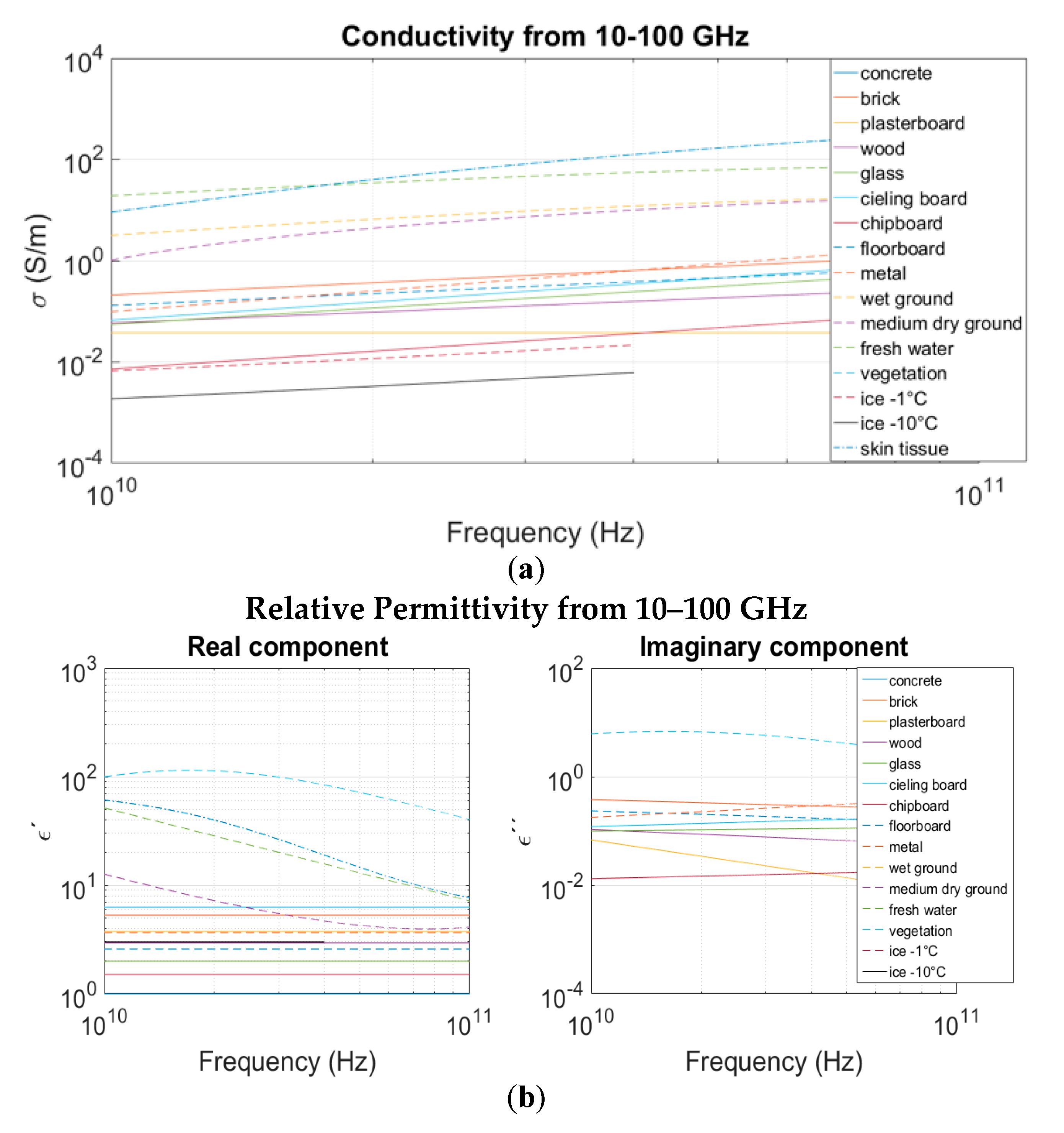
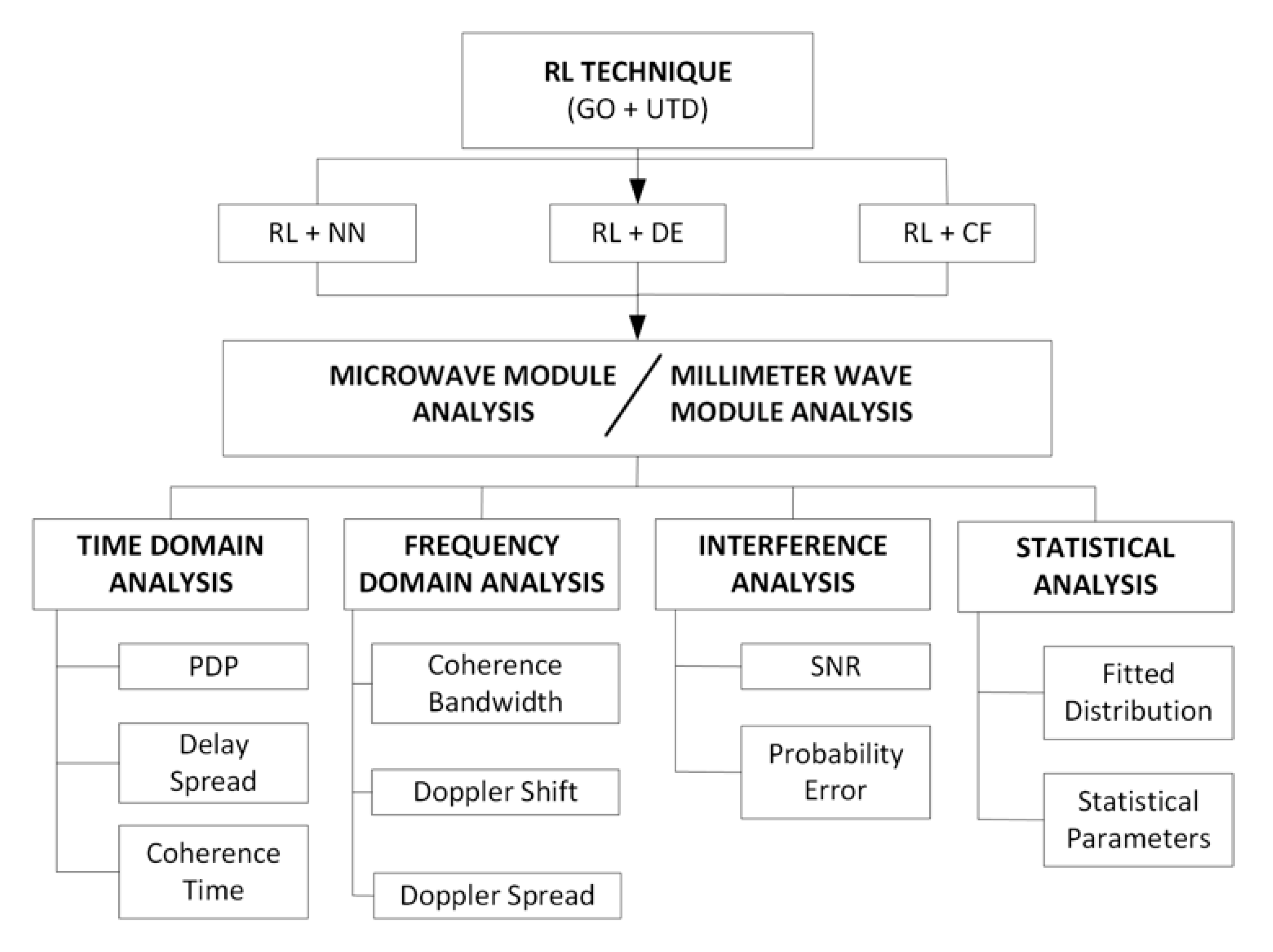
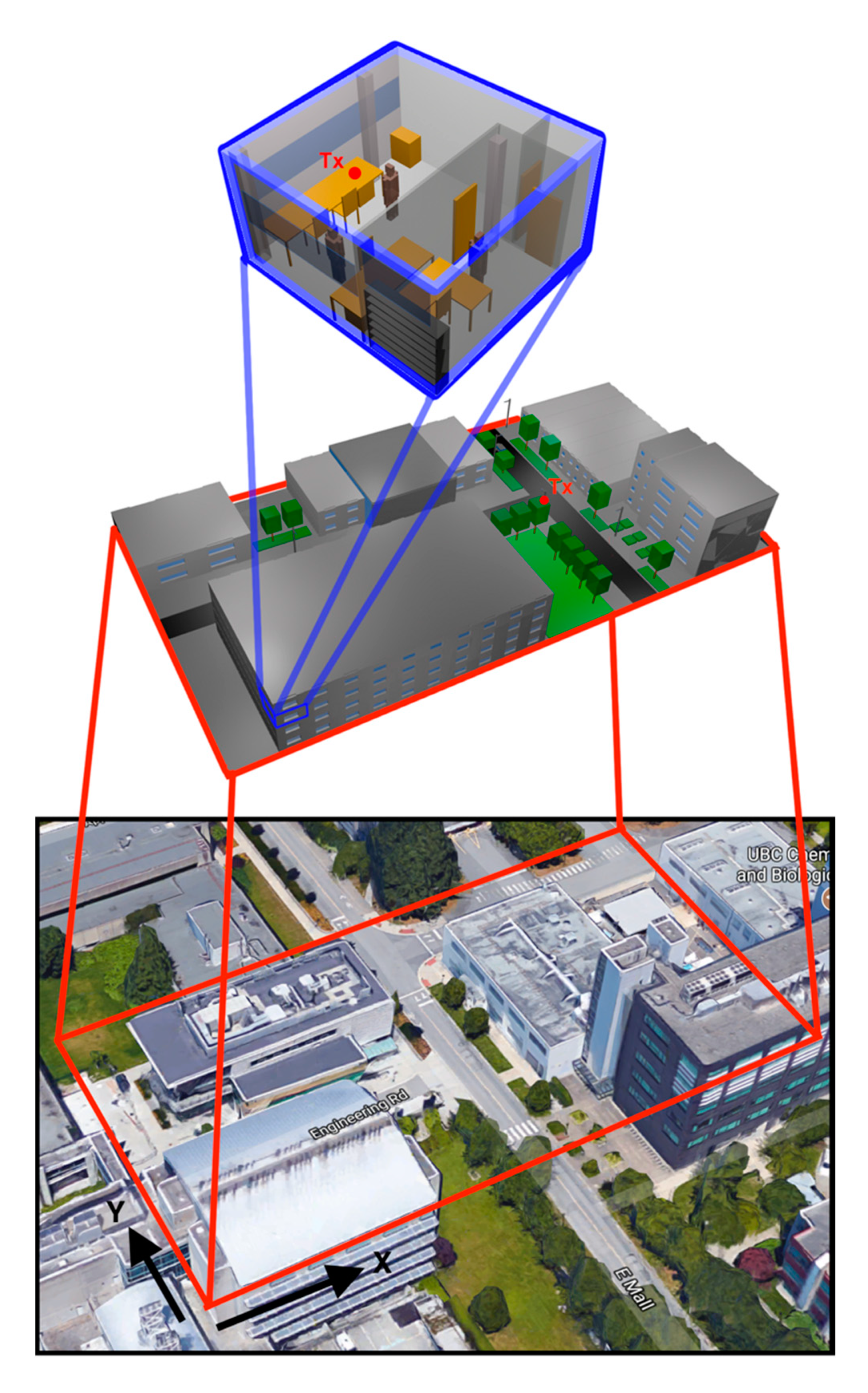
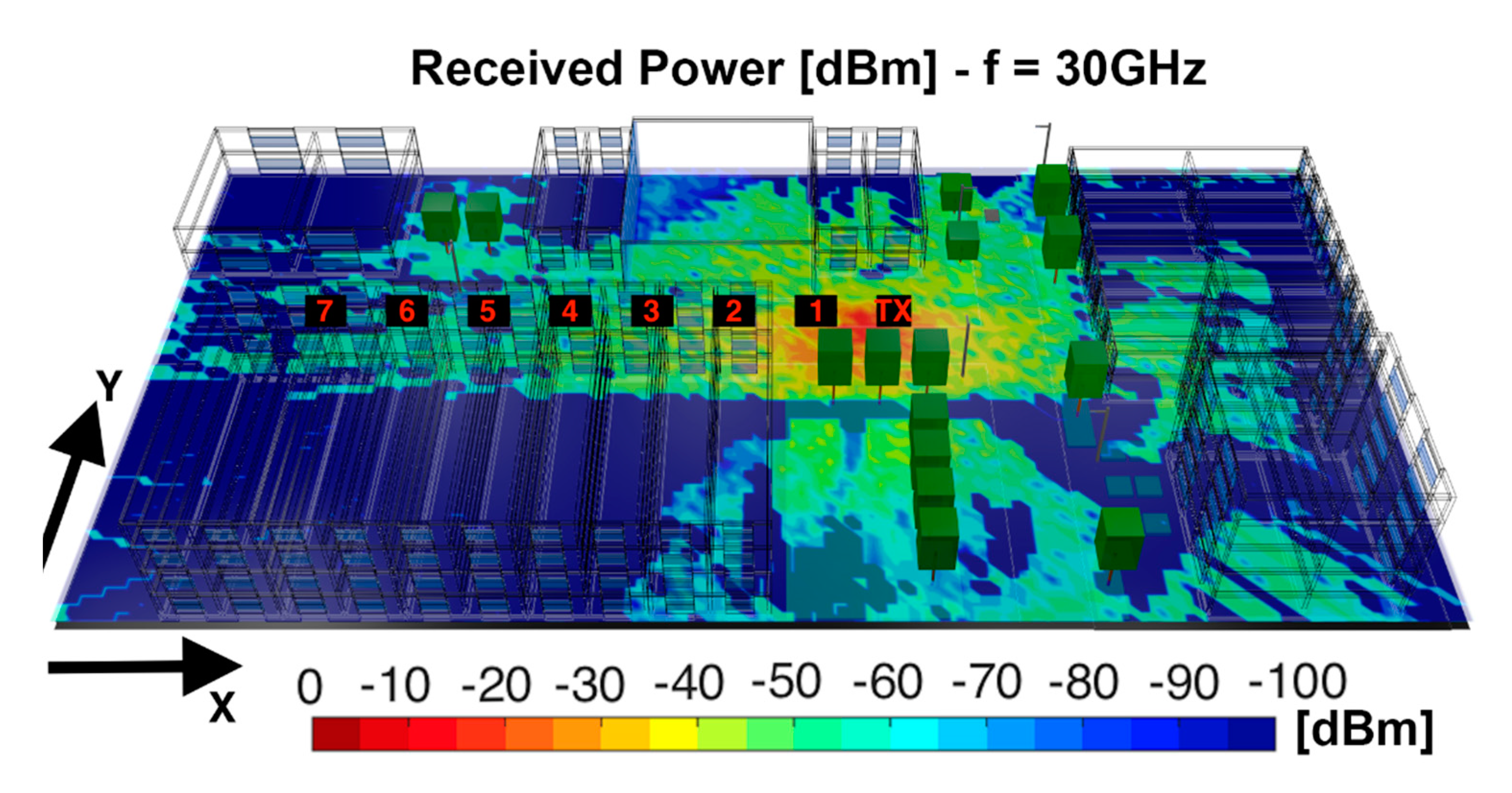
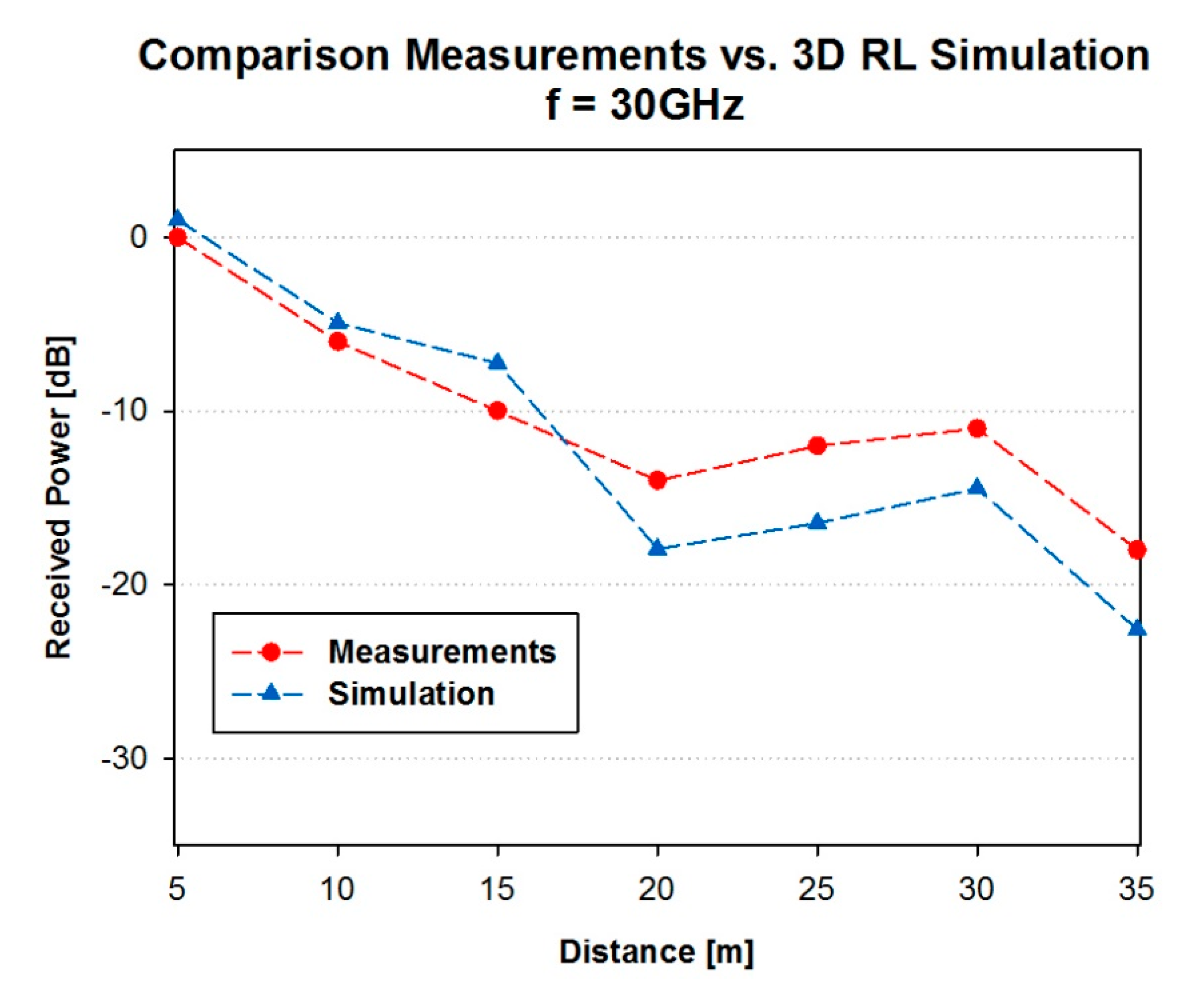
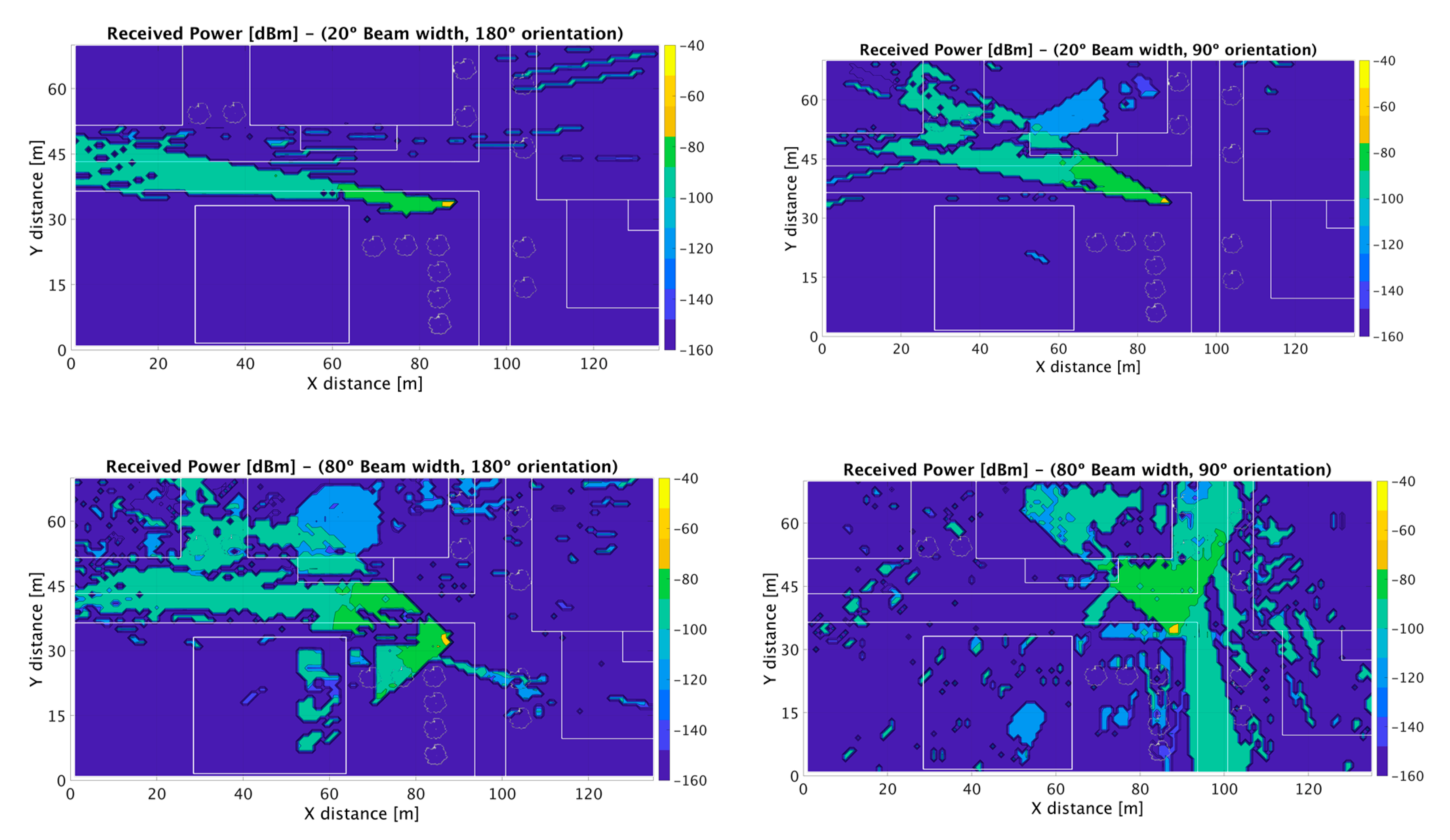
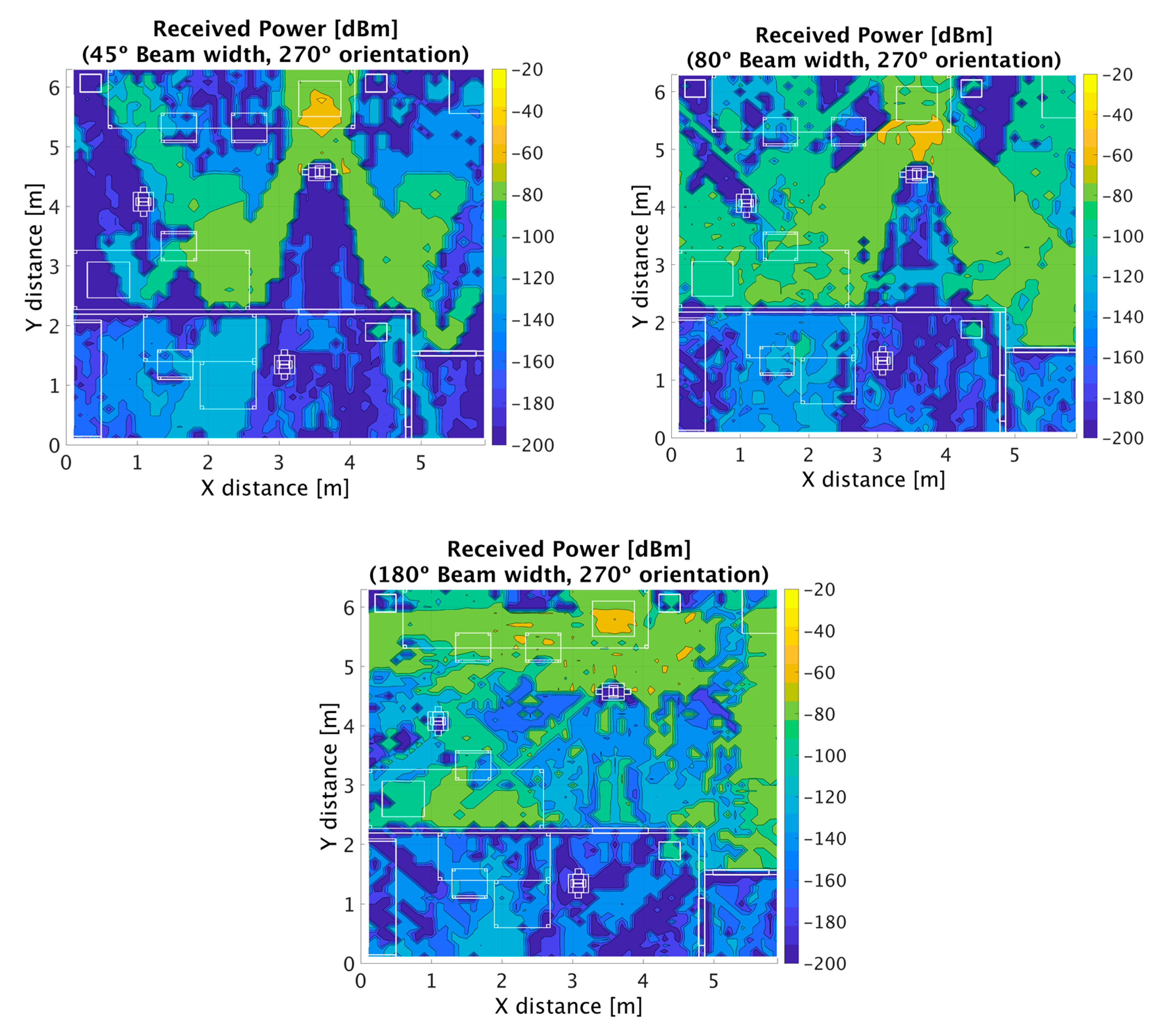


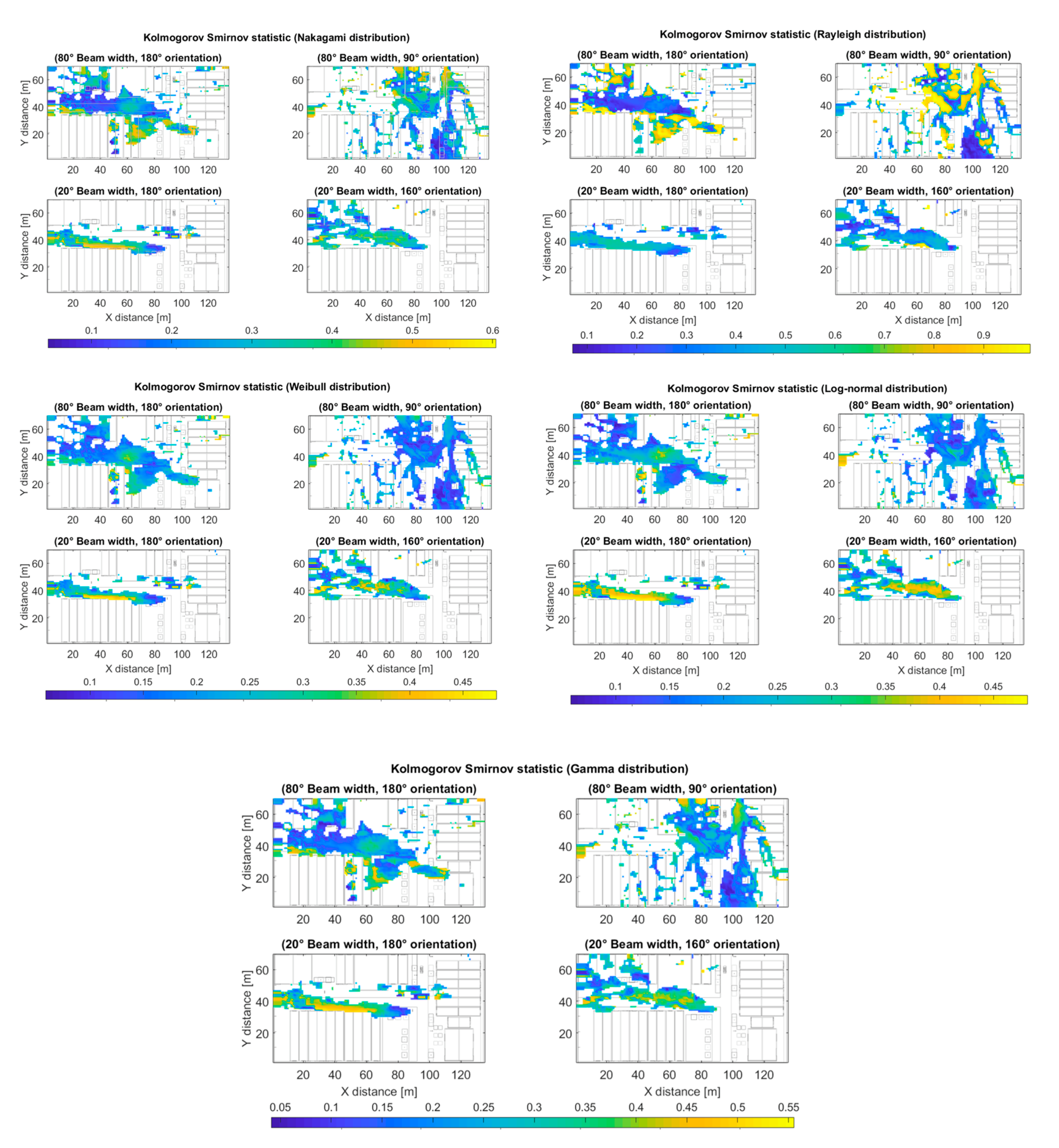
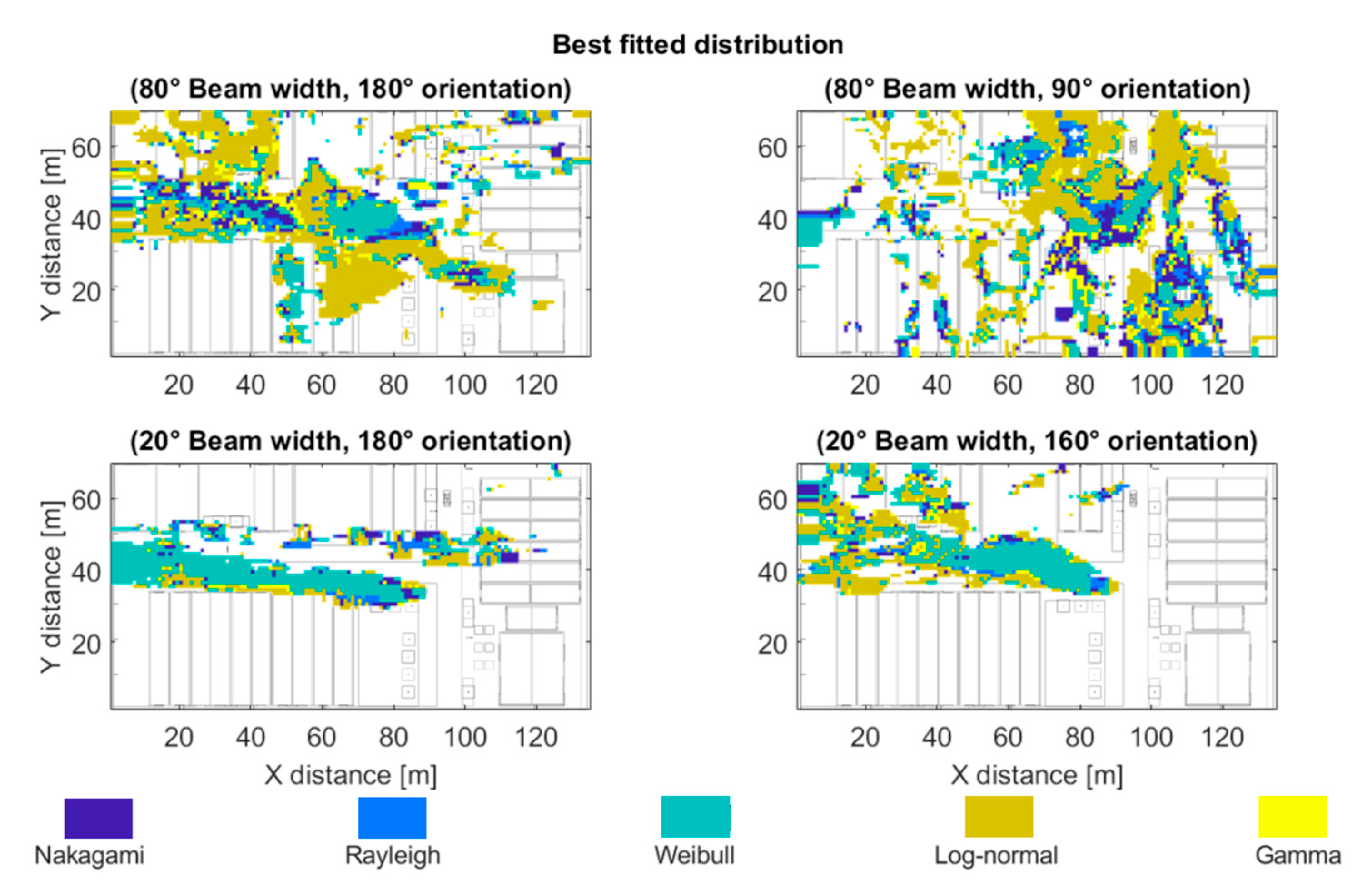
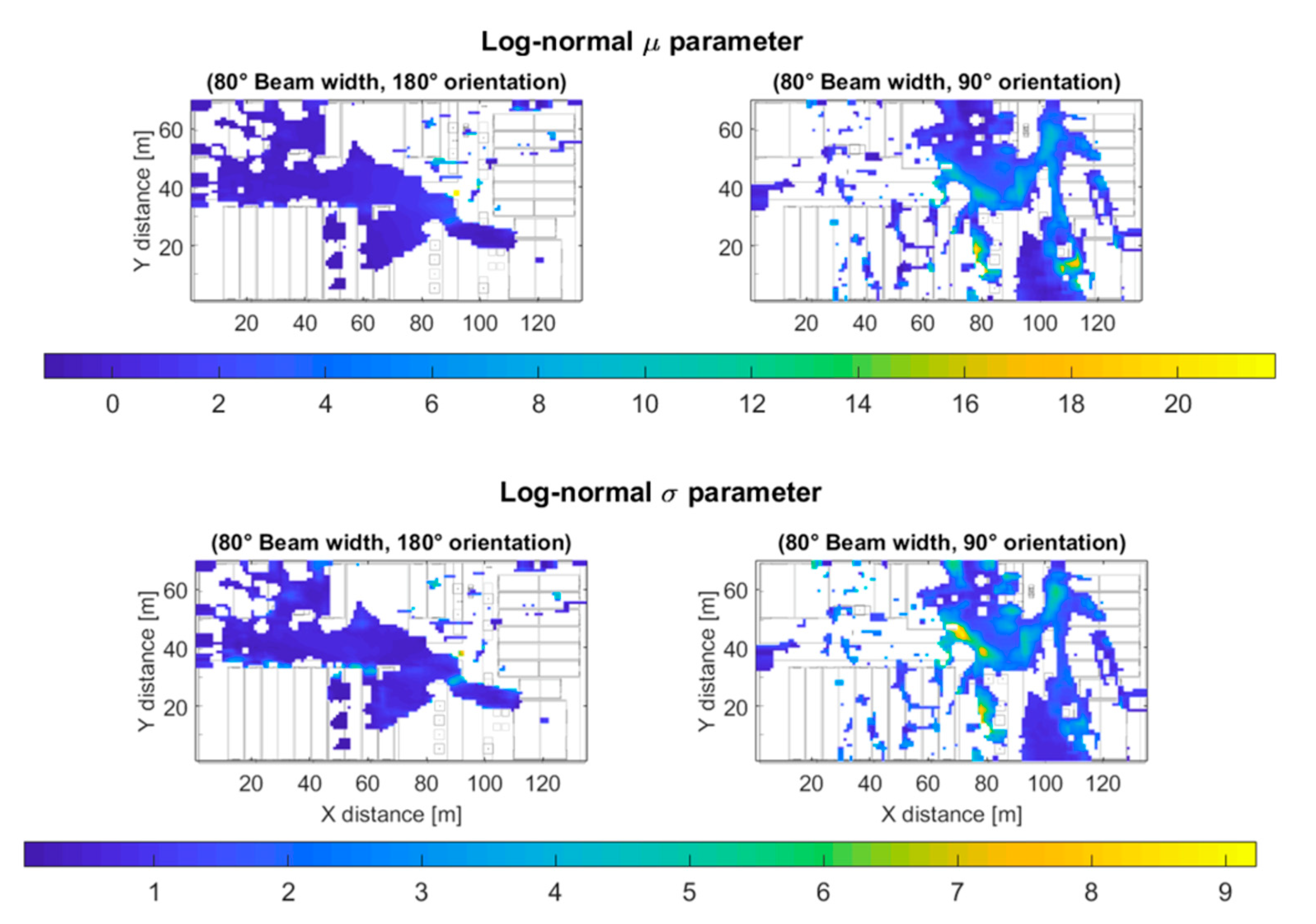
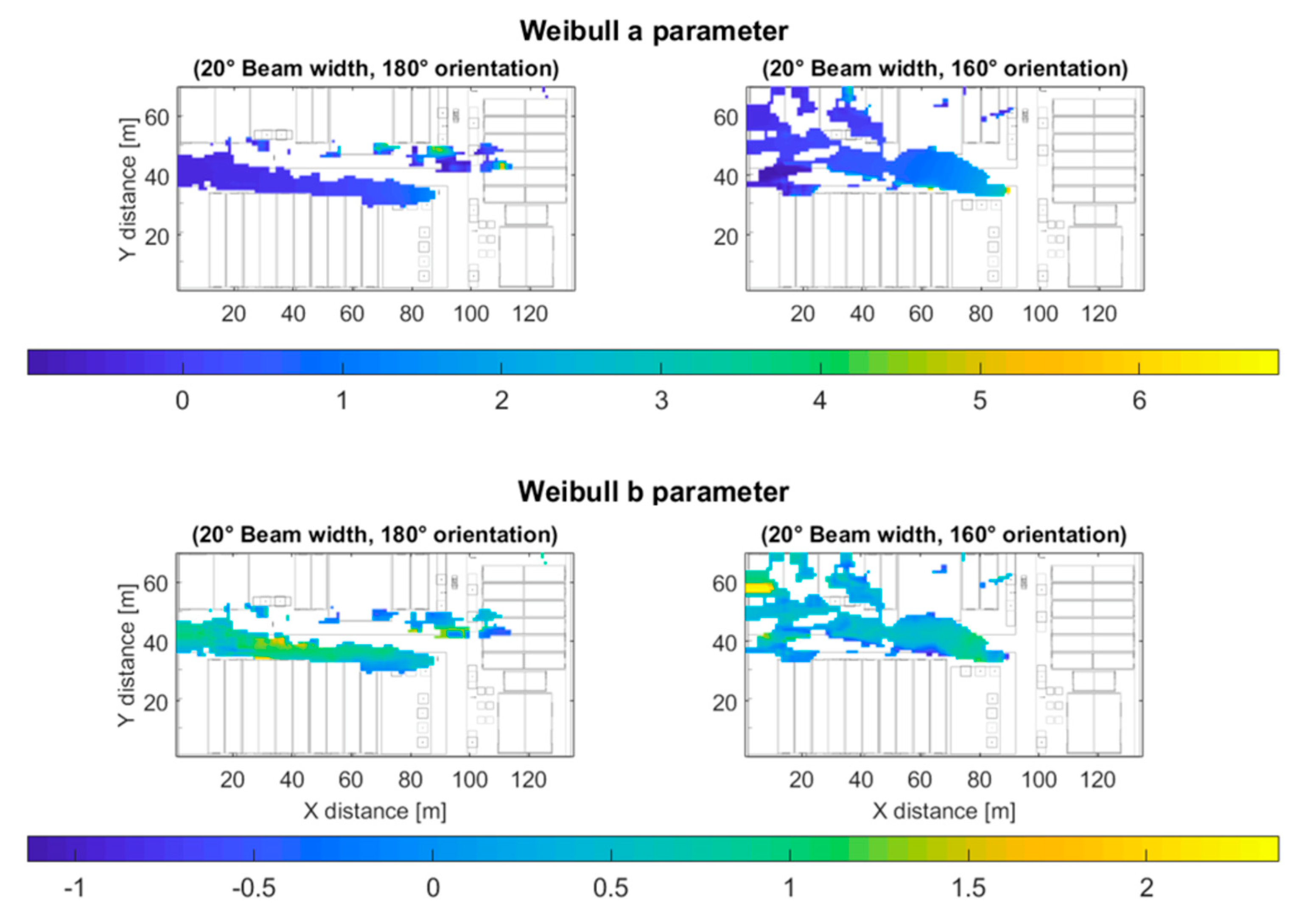
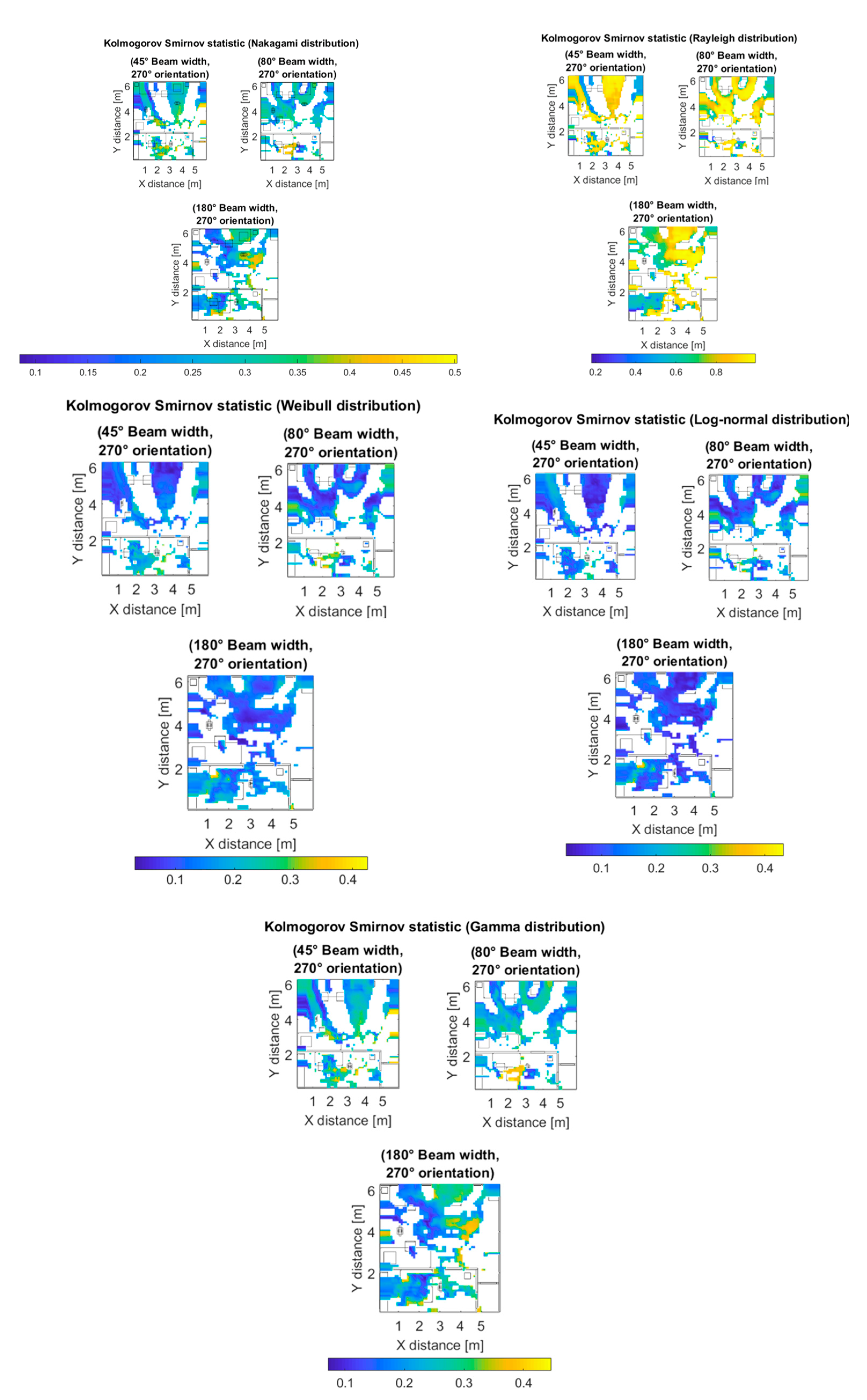
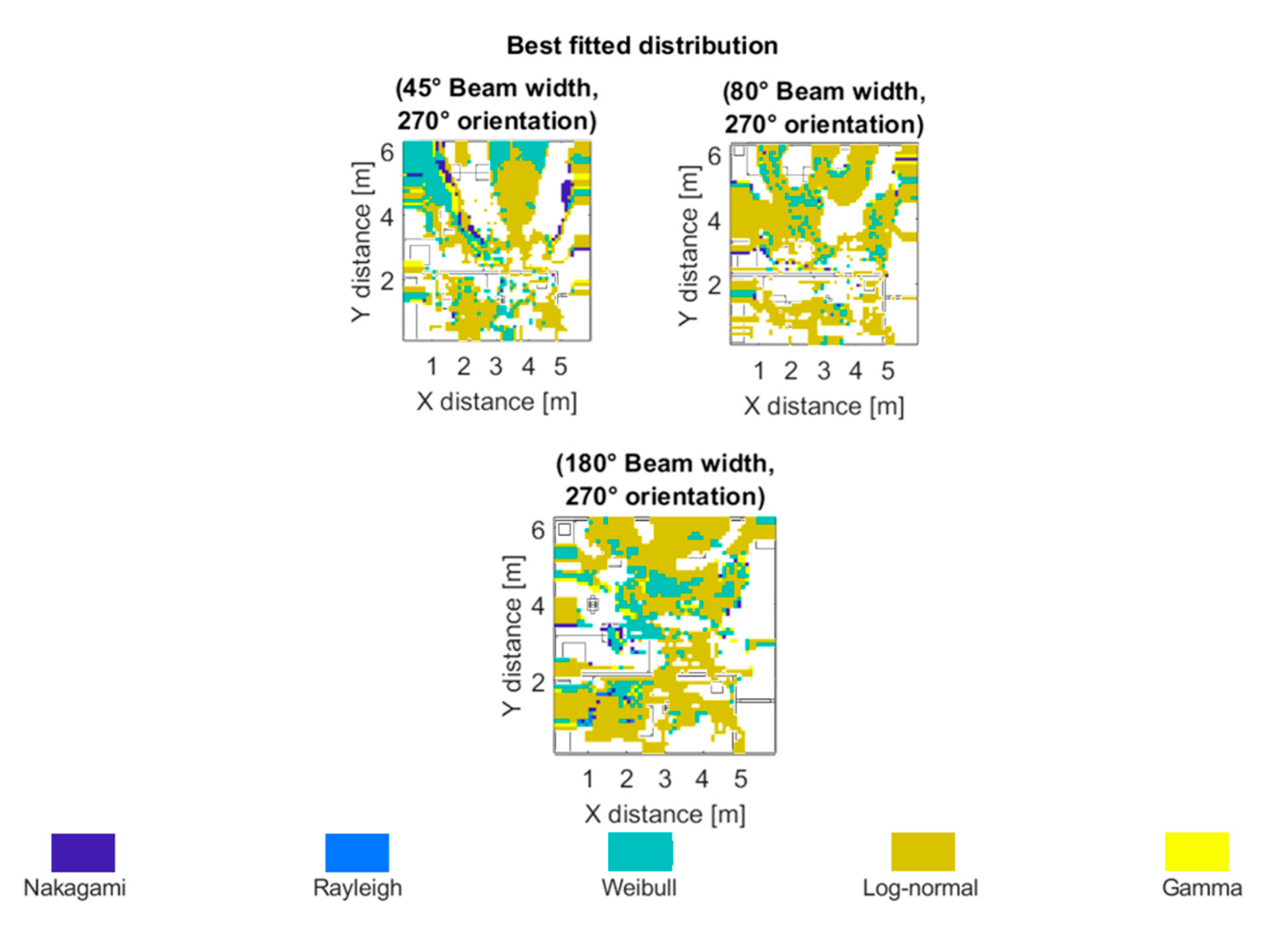
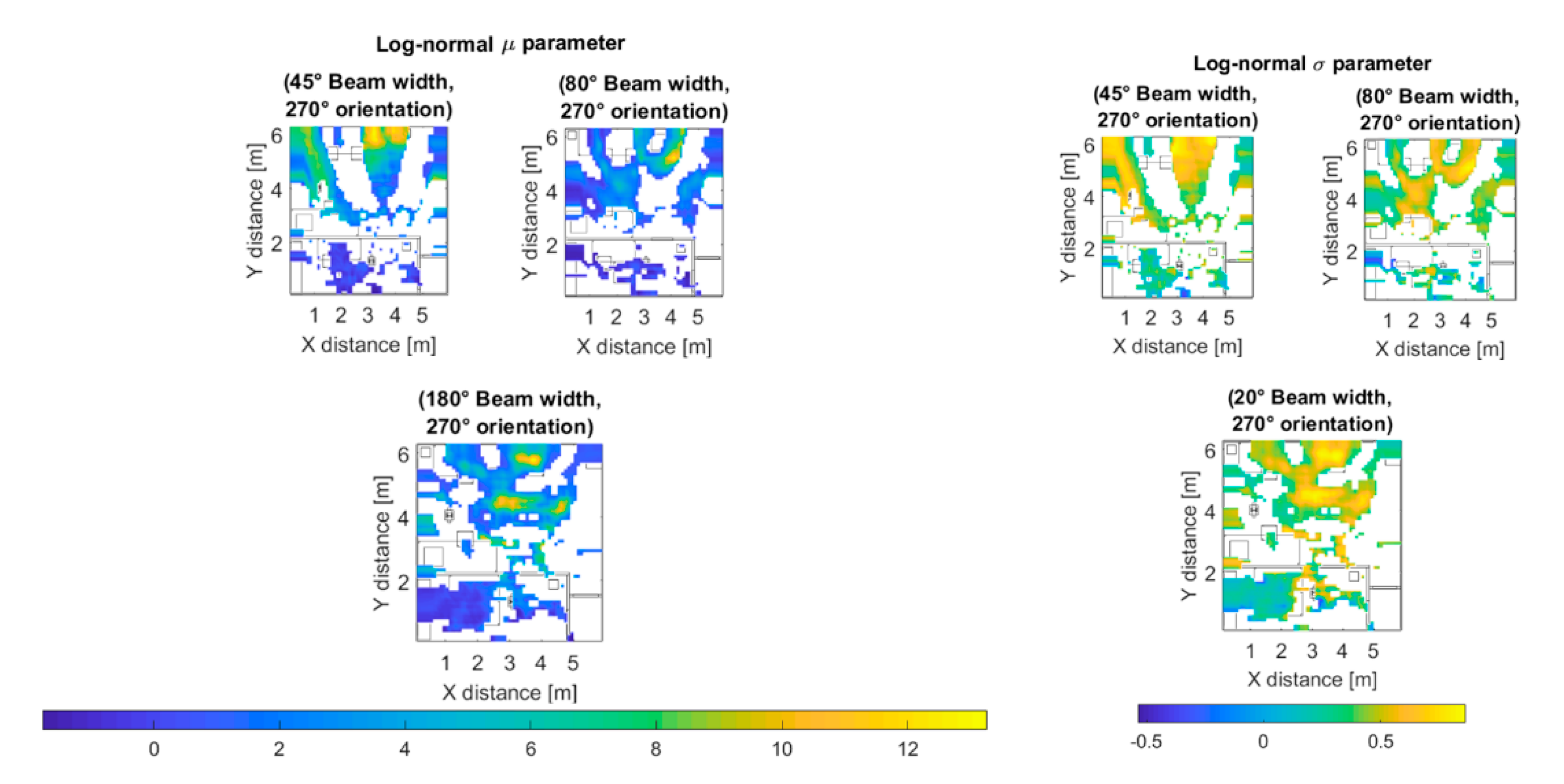

| Ref | Description | Results | Freq. |
|---|---|---|---|
| [17] | 3D mmWave statistical channel model | Extraction of a statistical channel impulse response model to obtain spatio-temporal characterization | 28 GHz/73 GHz |
| [18] | Semi-deterministic modeling based on ray tracing (RT) and graph theory | Multipath radio propagation is modelled with the aid of a graph theory-based approach, in which scatterers are modelled with realistic scenario elements. | 3.8 GHz/60 GHz |
| [22] | Wireless channel characterization in Fifth-Generation (5G) mmWave railway communications | Wireless channel characterization for different types of scenarios of operation (urban, rural, tunnel) are performed with the aid of RT and measurement results. | 25.25 GHz |
| [23,24] | Micro-cell urban (UMi) wireless channel modeling | Path loss model parameters are proposed employing random variables to consider channel dynamics. 3D RT is employed in [16] to obtain UMi wireless channel characterization | 28 GHz |
| [28,29,30,31,32,33,34] | Indoor characterization | Deterministic RT techniques are employed to characterize directional beam forming behavior in small indoor environments. Multiple-input-multiple-output (MIMO) behavior is analyzed, as well as multiple models proposed for different frequency ranges. | 5 GHz/28 GHz/31 GHz/70 GHz/90 GHz |
| [35,36,37] | Vehicular wireless communication channel characterization | Multiple aspects such as V2V/V2I wireless channel characterization or the impact of urban infrastructure and tunnels is addressed | mmWave/79 GHz/300 GHz |
| [38,39,40,41] | Topological and environmental impact in wireless channel characterization | Topological aspects, such as scenario type and beamforming characteristics are analyzed, the impact of environmental factors such as rain and the consideration of EMF compliance in wireless planning and analysis are described. | FR1/32 GHz/73 GHz/83 GHz |
| [42,43] | Application of artificial intelligence (AI) techniques in 5G mmWave wireless channel characterization | Different AI-based techniques are described in order to enhance functionalities such as beam forming or interference analysis, related with wireless channel characterization | Generalizable |
| Parameters | Outdoor Validation (Case I) | Outdoor Simulation (Case II) | Indoor Simulation (Case III) |
|---|---|---|---|
| Transmitted Power | 36 dBm | 10 dBm | 10 dBm |
| Operation Frequency | 30 GHz | 28 GHz | 60 GHz |
| Antenna beam width | Omnidirectional Monopole | 80°/20° | 180°/80°/45° |
| Transmitted data rate | 100 Mbps | 4.62 Gbps | 4.62 Gbps |
| 3D RL Resolution | 1° | 1° | 1° |
| Reflections | 6 | 6 | 6 |
| Scenario size (m) | 135 × 70 × 18 | 92.2 × 70 × 15 | 5.84 × 6.24 × 3.5 |
| Unitary volume analysis | 1 m | 1 m | 0.1 m |
| Transmitter Position (m) | (78.7, 40.3, 1.3) | (87.8, 32.9, 4) | (3.5, 5.8, 1.05) |
© 2020 by the authors. Licensee MDPI, Basel, Switzerland. This article is an open access article distributed under the terms and conditions of the Creative Commons Attribution (CC BY) license (http://creativecommons.org/licenses/by/4.0/).
Share and Cite
Azpilicueta, L.; Lopez-Iturri, P.; Zuñiga-Mejia, J.; Celaya-Echarri, M.; Rodríguez-Corbo, F.A.; Vargas-Rosales, C.; Aguirre, E.; Michelson, D.G.; Falcone, F. Fifth-Generation (5G) mmWave Spatial Channel Characterization for Urban Environments’ System Analysis. Sensors 2020, 20, 5360. https://doi.org/10.3390/s20185360
Azpilicueta L, Lopez-Iturri P, Zuñiga-Mejia J, Celaya-Echarri M, Rodríguez-Corbo FA, Vargas-Rosales C, Aguirre E, Michelson DG, Falcone F. Fifth-Generation (5G) mmWave Spatial Channel Characterization for Urban Environments’ System Analysis. Sensors. 2020; 20(18):5360. https://doi.org/10.3390/s20185360
Chicago/Turabian StyleAzpilicueta, Leyre, Peio Lopez-Iturri, Jaime Zuñiga-Mejia, Mikel Celaya-Echarri, Fidel Alejandro Rodríguez-Corbo, Cesar Vargas-Rosales, Erik Aguirre, David G. Michelson, and Francisco Falcone. 2020. "Fifth-Generation (5G) mmWave Spatial Channel Characterization for Urban Environments’ System Analysis" Sensors 20, no. 18: 5360. https://doi.org/10.3390/s20185360
APA StyleAzpilicueta, L., Lopez-Iturri, P., Zuñiga-Mejia, J., Celaya-Echarri, M., Rodríguez-Corbo, F. A., Vargas-Rosales, C., Aguirre, E., Michelson, D. G., & Falcone, F. (2020). Fifth-Generation (5G) mmWave Spatial Channel Characterization for Urban Environments’ System Analysis. Sensors, 20(18), 5360. https://doi.org/10.3390/s20185360










